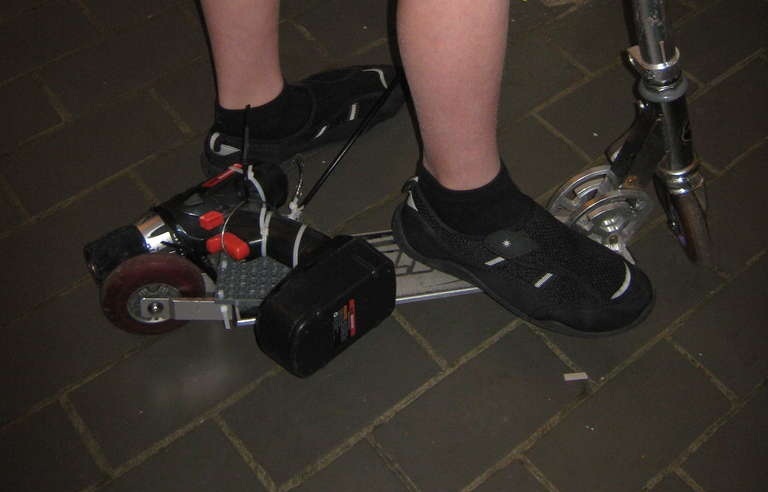Build an electric vehicle
Build a small battery powered model electric car using a motor, wheels, and recycled materials to learn circuits, propulsion, and simple design principles.



Step-by-step guide to build an electric vehicle
How Do Electric Cars Work?
Step 1
Gather all materials and place them on a clear table so you can reach everything easily.
Step 2
Cut a rectangle of cardboard about the size of your hand to make the car chassis.
Step 3
Cut two straws or wooden skewers a little wider than the chassis to act as axles.
Step 4
Make a centered hole in each bottle cap by pushing a pencil through so the cap can spin on an axle.
Step 5
Thread two bottle caps onto each axle leaving a little space so the caps can spin freely.
Step 6
Tape two straws under the chassis across the width to create supports for the axles.
Step 7
Slide the axles with wheels into the taped straws so the wheels spin freely under the chassis.
Step 8
Put a small drop of hot glue on the motor shaft and form a tiny knob to act as a pulley then let the glue cool.
Step 9
Loop a rubber band around the motor shaft pulley and around one wheel on the rear axle to make a belt drive.
Step 10
Tape or glue the motor to the chassis so the motor pulley lines up with the rear axle pulley.
Step 11
Attach the motor wires to the battery holder wires using clips or tape to complete the circuit connection.
Step 12
Insert the two AA batteries into the battery holder to power the motor.
Step 13
Place the car on the floor and let the motor run briefly to check that the belt turns the rear wheels.
Step 14
Adjust the wheel spacing or belt position until the car rolls straight and secure any loose parts with tape.
Step 15
Share your finished electric car on DIY.org.
Final steps
You're almost there! Complete all the steps, bring your creation to life, post it, and conquer the challenge!


Help!?
What can I use if I can't find the small DC motor or a battery holder called for in the instructions?
If you don't have the small DC motor or battery holder, salvage a motor and battery clip from an old toy or use a toothbrush vibration motor and tape two AA batteries together with wires as a simple battery holder, then follow the steps to glue a pulley and attach the rubber-band drive.
My wheels won't spin freely after I slide the axles in—what should I check or fix?
If the bottle-cap wheels don't spin, check that the pencil-made holes in the caps aren't too tight and that the taped straws under the chassis aren't squeezing the axles—widen the cap holes slightly, add a thin spacer on the axle, or loosen the straw supports so the wheels have the small free space described in the instructions.
How can I adapt this electric car build for younger or older kids?
For younger children, pre-cut the cardboard chassis and straws, pre-thread the bottle-cap wheels, and let them tape the motor and snap in batteries with supervision, while older kids can upgrade by adding a switch to the battery holder, using balsa wood for a sturdier chassis, or designing a gear train instead of the rubber-band belt following the same alignment steps.
What are some ways to extend or personalize the finished car beyond the basic build?
You can personalize and improve the car by painting the cardboard chassis, gluing on lightweight decorations, adding LED headlights wired to the battery holder with a resistor, or installing a second motor for more power while rechecking belt alignment and wheel spacing before sharing on DIY.org.
Watch videos on how to build an electric vehicle
Electric Vehicles - The Kids' Picture Show
Facts about electric circuits and model vehicle design
♻️ Using recycled materials like cardboard, bottle caps, and straws keeps junk out of landfills and makes creative, eco-friendly car parts.
⚡ Electric vehicles date back to the early 1800s — people experimented with battery-powered carriages long before gasoline cars took over.
🚗 Changing wheel size or gearing swaps speed for pushing power — bigger wheels or higher gear ratios make the car go farther per spin.
🔋 Many DIY toy car motors run on just 1.5–3 volts, so one or two AA/AAA batteries can power a tiny vehicle.
🔧 Small DC motors can spin at thousands of RPM, which is why simple gearing or rubber bands help turn that spin into smooth wheel motion.
How do you build a small battery-powered model electric car?
What materials do I need to build a model electric car?
What ages is building a battery-powered model car suitable for?
What are the benefits of building a small battery-powered model car?


One subscription, many ways to play and learn.
Only $6.99 after trial. No credit card required



